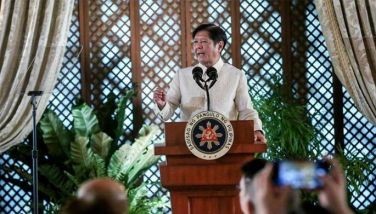DENR, LGU launch projects to save and protect Zamboanga coastal resources
February 21, 2003 | 12:00am
The Department of Environment and Natural Resources and the local government of Zamboanga have launched two projects to save and protect the city’s coastal resources and improve its quality of air.
Two Memoranda of Agreement (MOA) were signed by Environment Secretary Elisea Gozun and Zamboanga City Mayor Maria Clara Lobregat over the weekend for the launching of the "Mampang — Talon-Talon Coastal Resource Management Project" and the creation of "Task Force Usok."
The coastal and marine project seeks to protect the existing 15 hectares of mangroves already established in open mangrove areas in Barangay Mampang and Talon-Talon including the rehabilitation of some 50 hectares more.
The DENR said mangrove plantations are unique and form a vital part of the Philippine environment. They protect the coastline from erosions, serve as habitat for fish and nesting birds, and filter out silt that ruin the coral reefs. Mangroves are also integral part of the livelihood of local residents.
"Modernization and development has led to the conversion of mangrove areas for residential and industrial use, while the quality of air has suffered due to air pollution from human activities," Gozun said.
Under the MOA, the DENR would provide adequate funds, technical assistance and livelihood on areas cited for the project which will also include the development of the area into an eco-tourism destination.
There are about 300 hectares of mangrove areas, abandoned fishponds and saltbed in Barangays Mampang and Talon-Talon. In Zambonga del Norte, Silay City, and Banacon Island, there are model areas where fishery is integrated within mangrove areas. Mangrove areas were considered vast tracks that had to be converted for other uses during the ’70s. In 1967, the country had about 418,990 hectares of mangroves. At present, only 100,000 hectares are left.
Moreover, enforcers led by the Department of Transportation and Communication (DOTC), Land Transportation Office (LTO) and the Traffic Management Group (TMG) will conduct an intensified anti-smoke belching program in Zamboanga City. The program will include confiscation of licenses with DENR providing technical assistance on emission standards set by Republic Act 8749 (Philippine Clean Air Act of 1999).
According to the DENR, motor vehicles are the primary sources of air pollution, comprising 80 percent of emissions in the air. There were 3.9 million vehicles registered nationwide in 2001 of which 98,392 are from Zamboanga City alone. — Pia Lee-Brago
Two Memoranda of Agreement (MOA) were signed by Environment Secretary Elisea Gozun and Zamboanga City Mayor Maria Clara Lobregat over the weekend for the launching of the "Mampang — Talon-Talon Coastal Resource Management Project" and the creation of "Task Force Usok."
The coastal and marine project seeks to protect the existing 15 hectares of mangroves already established in open mangrove areas in Barangay Mampang and Talon-Talon including the rehabilitation of some 50 hectares more.
The DENR said mangrove plantations are unique and form a vital part of the Philippine environment. They protect the coastline from erosions, serve as habitat for fish and nesting birds, and filter out silt that ruin the coral reefs. Mangroves are also integral part of the livelihood of local residents.
"Modernization and development has led to the conversion of mangrove areas for residential and industrial use, while the quality of air has suffered due to air pollution from human activities," Gozun said.
Under the MOA, the DENR would provide adequate funds, technical assistance and livelihood on areas cited for the project which will also include the development of the area into an eco-tourism destination.
There are about 300 hectares of mangrove areas, abandoned fishponds and saltbed in Barangays Mampang and Talon-Talon. In Zambonga del Norte, Silay City, and Banacon Island, there are model areas where fishery is integrated within mangrove areas. Mangrove areas were considered vast tracks that had to be converted for other uses during the ’70s. In 1967, the country had about 418,990 hectares of mangroves. At present, only 100,000 hectares are left.
Moreover, enforcers led by the Department of Transportation and Communication (DOTC), Land Transportation Office (LTO) and the Traffic Management Group (TMG) will conduct an intensified anti-smoke belching program in Zamboanga City. The program will include confiscation of licenses with DENR providing technical assistance on emission standards set by Republic Act 8749 (Philippine Clean Air Act of 1999).
According to the DENR, motor vehicles are the primary sources of air pollution, comprising 80 percent of emissions in the air. There were 3.9 million vehicles registered nationwide in 2001 of which 98,392 are from Zamboanga City alone. — Pia Lee-Brago
BrandSpace Articles
<
>
- Latest
- Trending
Trending
Latest
Trending
Latest
Recommended






























